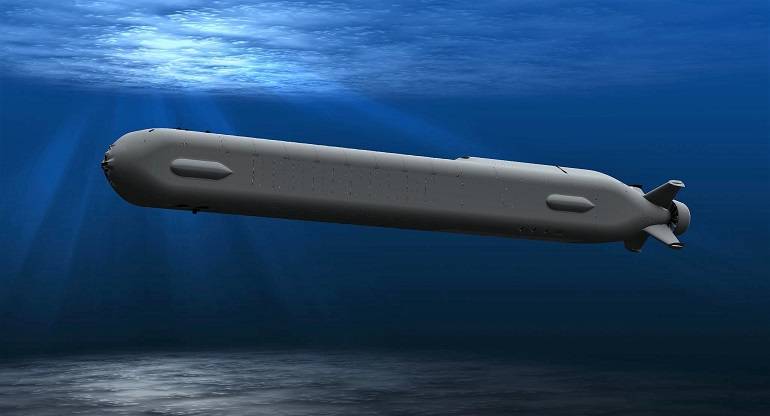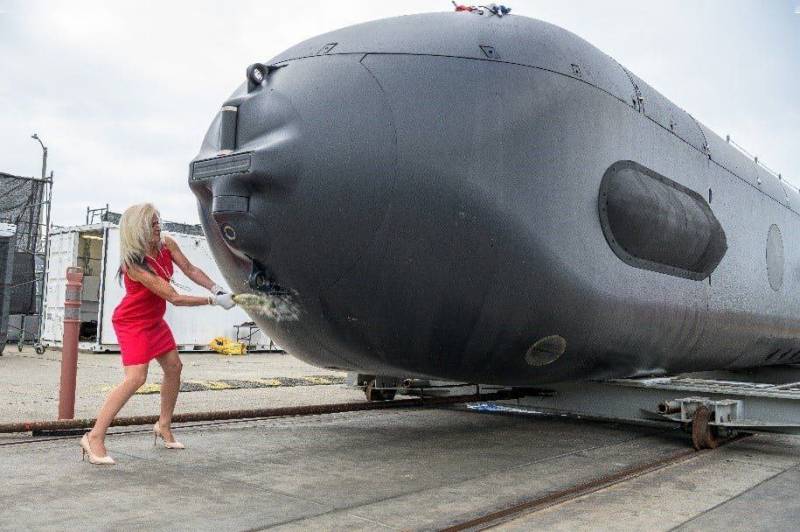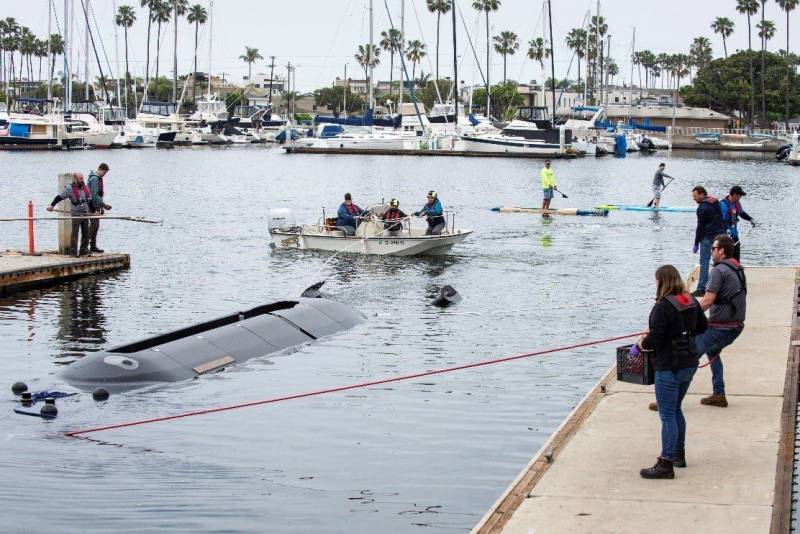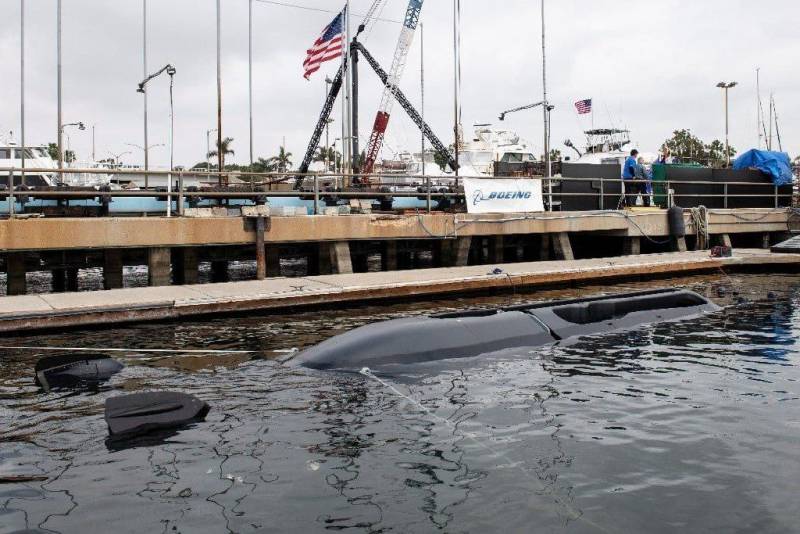The potential and capabilities of autonomous uninhabited underwater vehicles Orca XLUUV
At the end of April, the first experimental autonomous underwater vehicle Orca XLUUV developed by Boeing and Huntington Ingalls Industries was launched in the United States. This year, four more products will be completed, with the help of which they will conduct full-scale and comprehensive tests. During these activities, the prototypes must confirm the design characteristics and demonstrate the ability to solve a wide range of tasks using weapons and special equipment.
From blueprint to water
The development of the future AUV Orca ("Orca") has been commissioned by the US Navy since 2017 as part of the XLUUV (Extra-Large Unmanned Undersea Vahicle) program. At the beginning of 2019, the project of Boeing and Huntington Ingalls Industries became the winner of the competitive stage of the program. They received contracts to continue development ($43 million) and to build five prototypes ($274 million)
In the recent past, the project was successfully completed, after which the construction of the ordered equipment began. Part of the structures of the experimental Orca XLUUV is manufactured by HII in Huntington Beach, after which it is delivered to the neighboring Boeing plant for further assembly and installation of equipment. On April 28, the first of the ordered samples was launched, and the rest will be made before the end of the year.
The prototypes will reportedly go through sea trials first to test and fine-tune key systems. In the future, after the formation of the entire "squadron", tests will begin with the use of one or another target equipment and weapons. It is reported that at first the device will master the installation of sea mines. Then it is planned to determine the capabilities of the Orca in solving other problems, as well as to form the optimal tactics for their use.

After completion of such tests and studies, Orca XLUUV can go into series. In the distant future, the US Navy plans to create a large fleet of AUVs capable of solving certain tasks in different areas of the oceans. How soon he will appear, and what he will be able to do, depends on the results of the recently begun work.
Perspective appearance
Orca XLUUV is a small diesel-electric submarine with autonomous control systems. The AUV is built in a streamlined hull of high elongation with a rounded nose. In the stern, planes with rudders and a jet propulsion are provided. Product length - 26 m with a diameter of approx. 3 m. Displacement - 80 tons.
It is reported that Orca is equipped with a diesel-electric power plant with full electric propulsion. When surfaced or under the snorkel, the AUV will generate power and recharge batteries for scuba diving. The maximum travel speed will reach 6-8 knots with an economic approx. 3 knots. Autonomy is defined as several months; on one refueling and with repeated recharging of batteries, the cruising range will reach 6500 nautical miles.
A key component of the XLUUV program is a new autonomous control system with a set of necessary sensors and tools. First of all, she is responsible for driving the device along a given route, taking into account emerging situations and factors. In addition, the control system will interact with the operator and other AUVs. By installing the necessary software modules, the application of the target load will be ensured.
For special equipment, the Orca has a compartment 10 m long; carrying capacity - 8 tons. The AUV will be able to carry hydroacoustic stations of various types, a variety of radio equipment, including radar and electronic warfare systems, or other devices. The possibility of deploying weapons is also being considered. It was recently announced that the Orca XLUUV will be able to carry and drop naval mines of suitable dimensions. It is possible to integrate torpedoes of modern or advanced types.
Platform Advantages
The goal of the Orca XLUUV project is to create a multi-purpose autonomous underwater complex. Its potential largely depends on the characteristics and capabilities of the base platform, which is the new AUV. Indeed, the declared parameters and functions attract attention and allow us to talk about the presence of certain advantages.
The uninhabited design of the underwater vehicle is of great importance - and it is for this reason that the AUV direction receives the necessary attention and develops. The absence of a crew makes it possible to reduce the dimensions and weight of the structure, make optimal use of internal volumes, and also maximize autonomy.
An important technical achievement will be an autonomous control system with all the necessary functions and the possibility of their expansion. Such a system will be tested, and then it will find practical application on the Orca. Then the developments from this project can be used to create future AUVs.
The diesel-electric power plant is built according to a well-mastered scheme. At the same time, it should provide high autonomy and cruising range - although at the cost of reducing the maximum speed. The AUV has full electric propulsion, which should minimize noise and make it difficult to detect underwater.
Load Capabilities
The heavy Orca is capable of carrying a variety of payloads, incl. large and heavy - up to 8 tons in the 10th compartment. This is already an important advantage over other modern AUVs. In this case, the special equipment will be made interchangeable, and the installation of a new module should not be difficult.
First of all, Orcas will become carriers of hydroacoustic equipment. It will allow the devices to search for various underwater targets, from enemy submarines to sea mines. Patrolling will be carried out by single AUVs or groups. In all cases, a longer sailing time will increase the efficiency of the operation - by covering a larger area and exchanging data.
Orca XLUUV can also carry radio equipment - locators or jamming stations. With the help of AUV groups with radar, it is possible to monitor large areas of the open sea. The devices will be able to stay at the given positions or move along the required route. If necessary, they will be able to go under water to avoid detection or defeat. EW stations will be used in the same way.
AUVs with installed sonar or radar equipment can theoretically replace a wide range of other means fleet. He can take on the tasks of submarines, patrol aircraft, etc. At the same time, in some cases, high autonomy will become a fundamental advantage.
The idea of using mine-torpedo weapons has great potential. Having received a GAS and a torpedo, the Orca will be able to search for and hit underwater or surface targets. Large groupings of such armed AUVs can become an effective means of submarine warfare. In addition, the device will be able to secretly set or neutralize mines. Characteristics and capabilities in this case directly depend on the type of weapons used.
Project of high complexity
In general, the promising uninhabited underwater vehicle Orca XLUUV is of great interest in terms of technology, operation and application. It is clear why this project received the support of the US Navy and has already been brought to the testing stage. In addition, it is clear that everything possible will be done for its further development, up to the adoption of equipment for service.
However, Boeing, HII and various structures from the Navy are facing very difficult tasks. The high potential of Kasatka is based on various new solutions and technologies, most of which need to be developed and fine-tuned. All of them will be checked and worked out during the next tests, single and group.
At the next stage, with the help of several Orca XLUUVs, they will work out tactics for the group use of such equipment. The fleet and contractors will have to find the best methods of work, as well as identify and correct possible problems in the interaction of several AUVs and the operator. The high complexity of this part of the project results in corresponding technical risks.
The price of progress
Thus, the Orca XLUUV autonomous underwater vehicle project is successfully moving forward and has already reached the stage of sea trials. In the near future, several new prototypes are expected to appear and the next, more complex test phase will begin. It will show the real prospects of the project, as well as determine the place of new equipment in the fleet.
How long this work will last and how it will end is not yet known. However, it can be assumed that the Navy and their contractors will do everything possible to successfully complete the Orca project. The XLUUV program promises the US Navy the most significant benefits and benefits - and they will fully justify all the efforts invested.





Information